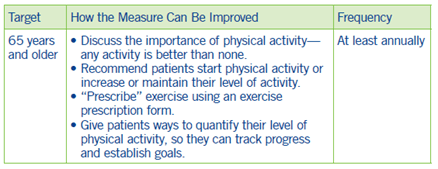Monitoring Physical Activity
Clinical Basis
Staying active is perhaps the single most important factor in maintaining an older adults’ quality of life. Regular physical activity protects joints, prevents falls and injuries, positively affects brain health, and reduces risk of chronic disease.

Assess
Based on your practice’s specific workflows and resources, consider integrating the assessment in:
- Annual wellness visit
- Pre-visit paperwork
- Office staff workflow
Ask:
Tell me about your physical activity.
- How much? How often? What kind?
- Note: use “physical activity” rather than “exercise” when discussing with your patient. “Exercise” often conjures images of going to a gym, when physical activity encompasses many more activities.
Discuss
Talk to the patient about their lifestyle and interests. It is important to understand what the patient’s current life is like so that physical activity can be integrated. Talk to the patient about the importance of physical activity, including potential positive outcomes. Use this opportunity to discuss chronic and/or disabling conditions that may be impacted by activity.
Manage
The key to encouraging physical activity in patients is providing specific recommendations. Whether a patient is sedentary or an avid tennis player, it is best to advise them specifically to start, increase, or maintain their physical activity. For patients, it is best to recommend achievable goals such as to start taking the stairs, increase walking from 10 to 20 minutes every day, or maintain their current exercise program.

